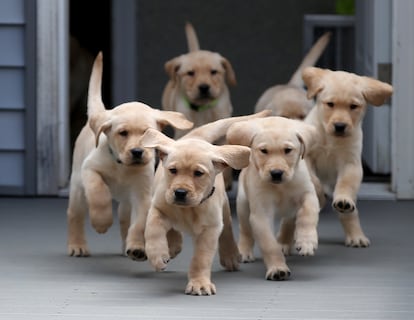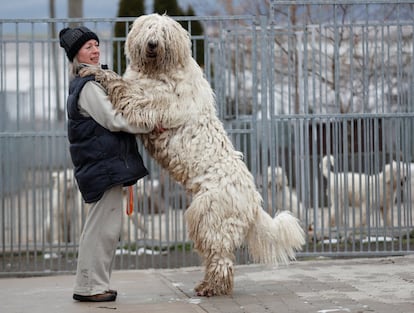Your pup’s personality is unrelated to their breed
A new worldwide study disproves the idea that certain dog breeds have particular character traits

A genetic study of 2,000 dogs, cross-referenced with surveys of 18,000 owners, has found that the breed of a dog does not necessarily determine its personality. The study, published this week in the journal Science, showed that the behavior of individual dogs is highly variable and practically independent of genetic inheritance.
In other words, explains lead researcher Elinor Karlsson, you can’t have a Great Dane the size of a Chihuahua, or vice versa. But you can have a Great Dane that behaves exactly like a Chihuahua – and vice versa.
128 breeds were represented in the study, in which Karlsson and her team compared each dogs’ genetic data (most of the 2,000 dogs had their entire genomes sequenced) with the results of surveys gathered from dog owners, looking at characteristics such as sociability with humans and with other dogs, aggressiveness, tendency to use toys, and docility. The researchers found that there are genetic regions strongly associated with behavior, but none were breed-specific. As the study concludes, “although breed may affect the likelihood of a particular behavior occurring, breed alone is not, contrary to popular belief, informative enough to predict the disposition of an individual.”
We may tend to believe, for example, that certain breeds are good with children, or others are more skittish. However, Karlsson’s study shows that when an animal is adopted it is not really possible to know anything about their character. The professor notes that breed accounts for just 9% of variation in behavior in individual dogs while, for certain behavioral traits, age is a better predictor. Karlsson, associate professor at the University of Massachusetts, also notes that stereotypes about particular breeds vary between cultures – characteristics attributed to a breed in the US are different, for example, in France.

“Just like in humans, behavior in dogs is complex, which means that it is controlled by changes in many, many different genes,” says Karlsson, adding that there is also a large environmental component. Factors such as the maternal environment, early socialization, and experiences of trauma can all have an impact on a dog’s genetic makeup. As such, a genetic study selecting for complex behavioral traits would take many centuries.
Dog breeds: They’re not peas in a pod
The general traits that define all dogs – docility, sociability with people, the ability to interact by picking up an object or looking where the owner indicates – began to emerge through genetic selection some 15,000 years ago. They have a common ancestor in today’s wolves, and they are thought to have self – domesticated out of an interest in sharing their lives with humans.
But those of all dogs are practically the same, it only varies in a handful that influences accessory aspects such as the shape of the ears or the length of the hair. And that is why they constitute the same species: the recipe is the same, although some have more salt or less pepper, depending on their appearance. Aesthetics, and not behavior, have been the focus of selection, they note in the study: “We found no evidence that behavioral trends in breeds reflect intentional selection by breeders, but we cannot exclude the possibility “.
It was only in the mid-nineteenth century that breeds began to be differentiated according to fixed characteristics considered to define them, such as the spots on Dalmations or the bulky body of mastiffs. Still, the characteristics of all dogs are practically the same, with variation on only a handful of ‘accessory aspects’ such as ear shape or hair length. To be sure, this is how they are the same species: the recipe is the same, it’s just that their appearance may differ. The study emphasizes that genetic selection has occurred in the aesthetics of dogs, not their behaviors, saying that, while “we cannot exclude the possibility”, “we found no evidence that behavioral trends in breeds reflect intentional selection by breeders.”
Carles Vilà is a specialist in evolutionary genetics at the Spanish National Research Council, and did not participate in Karlsson’s study. Vilà explains that behavioral traits in dogs “are not determined by a single gene, but by many”, which makes it more difficult to predict the outcome of crossing genes or breeds.
“They are not like Mendel’s peas,” says Vilà, referring to the scientist Gregor Mendel’s 19th century experiments with peas that proved how genes are inherited and formed the basis for modern genetics. Where the peas varied in texture and color – “smooth, wrinkled, green or yellow – in dogs there are many levels of variation and many genes involved
So, “a great deal of variation can be found in offspring,” says Vilà, who has also studied canine lineages. Hence, it is not possible to have a Chihuahua the size of a Great Dane, but they behave the same.

The material for the study – 200, 000 responses from more than 18,000 dog owners – was gathered via Darwin’s Ark, a giant citizen science repository that collects data online from all over the world. With such a broad reach, the researchers were able to conclude that no behavioral traits in dogs are exclusive, or foreign, to any breed. Labrador Retrievers, for example, have the lowest propensity for howling, but 8% of owners still reported that their Labrador howls.
“The differences between breeds for certain behaviors reflects a subtle but real shift in the spectrum of behaviors within breeds. On average, a border collie is more biddable than any random dog,” says co-author Kathleen Morrill. “But there is still a wide variation in biddability among border collies, so predictions of individual behavior are error-prone”.
There are breeds that have a greater tendency than others to show some behaviors – it is very likely that a bloodhound howls, and it is more difficult to find an obedient beagle – but they all move within the same variable spectrum
So what’s different about guide dogs, sheepdogs, and guard dogs? How to explain the traits of dogs that have been bred to perform specific tasks? Karlsson says it’s environmental: “If you have a population of guide dogs where you’re selecting individuals that are fantastic guide dogs, they will have population – enhanced behavioral differences in that group.” For this reason, dogs bred for herding show greater obedience than, for example, a chihuahua.
So does it make sense to classify certain breeds as more dangerous? Karlsson’s study analyzes the prevalence of a trait, the ‘agonistic threshold’, which measures the ease with which a dog feels provoked by stimuli that cause fear, discomfort or annoyance. The study found that the breed provides almost no information for that aspect.
At a press conference, Karlsson clarifies that “When we studied the agonistic threshold, which included many questions about whether people’s dogs reacted aggressively to situations, we did not see the ancestry of their breed as having an effect on that particular factor.” Therefore, cataloging traits as particular to breeds “doesn’t make much sense to us.”
Vilà says the study’s conclusions are significant.
“We often pigeonhole animals, saying they must be this way or that.”
The expert says Karlsson’s study shows the importance of taking aspects other than breed into account – “the family environment, how the animal has been raised, age are other factors that are very important.”
Tu suscripción se está usando en otro dispositivo
¿Quieres añadir otro usuario a tu suscripción?
Si continúas leyendo en este dispositivo, no se podrá leer en el otro.
FlechaTu suscripción se está usando en otro dispositivo y solo puedes acceder a EL PAÍS desde un dispositivo a la vez.
Si quieres compartir tu cuenta, cambia tu suscripción a la modalidad Premium, así podrás añadir otro usuario. Cada uno accederá con su propia cuenta de email, lo que os permitirá personalizar vuestra experiencia en EL PAÍS.
¿Tienes una suscripción de empresa? Accede aquí para contratar más cuentas.
En el caso de no saber quién está usando tu cuenta, te recomendamos cambiar tu contraseña aquí.
Si decides continuar compartiendo tu cuenta, este mensaje se mostrará en tu dispositivo y en el de la otra persona que está usando tu cuenta de forma indefinida, afectando a tu experiencia de lectura. Puedes consultar aquí los términos y condiciones de la suscripción digital.











































